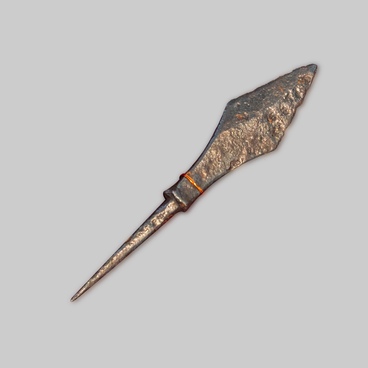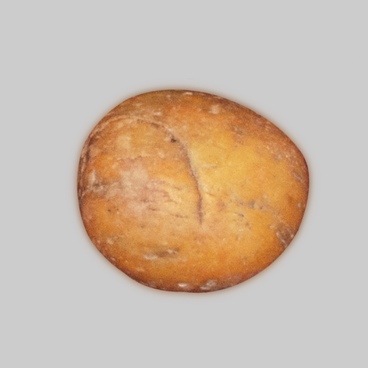The ramrod was found in excavation of a XVII century house in Kuznetsk ostrog. It is a wooden stem with an iron point. The upper part of the point is Y-shaped, its ends parted at an obtuse angle. The ramrod was easy to manufacture, it was used to clean the barrel from inside and to remove the bullets.
Most of Kuznetsk ostrog population were the service class people – military estate. Firearms like arqubuses, escopets, trigger-based handarms and pistols were in permanent use. And a ramrod is an ordinary article to discover in a living house in Kuznetsk.
The ramrods could be one-piece and disassemblable consisting of several parts. The first firearms were muzzle-loaded, like, for example, escopets. The ramrods could also be used to load the bullets and the wads separating the powder in the cartridge from the bullet.
A ramrod for a modern army gun usually has a screw thread at the end: the accessories for cleaning and lubricating the firearms are screwed to it. Such ramrod is attached under the barrel. There also existed certain exotic locations on the firearms where the ramrod could be stored. For instance, in a German assault rifle Stg-44 it is kept inside the gas piston mechanism.
The Russian for ramrod is ‘shompol’ coming from the German stempel, meaning pestle, stem. Usually, the ramrods were made of steel, earlier they used to be wooden stems, or the stems made of wood with metal. They were used to drive out the cartridges and empty cartridge cases stuck in the bore, and for cleaning and lubricating the barrels of hand firearms or pneumatic arms.
At early stages of the firearms development the ramrod was indispensable for muzzle-loaded weapons – it helped drive the bullet into the barrel until the stop limit. For Nesler bullets and other pointed bullets ramrods with a relevant shape of the head were used. When loading rifled muzzle-loaded rifles of XVI–XIX centuries— escopets – the bullet needed to be knocked into the bore using the ramrod. Invention of Minie bullet allowed cancelling bullets knocking into the bore, and since that time, the ramrod has no longer been required in the combat equipment.
Most of Kuznetsk ostrog population were the service class people – military estate. Firearms like arqubuses, escopets, trigger-based handarms and pistols were in permanent use. And a ramrod is an ordinary article to discover in a living house in Kuznetsk.
The ramrods could be one-piece and disassemblable consisting of several parts. The first firearms were muzzle-loaded, like, for example, escopets. The ramrods could also be used to load the bullets and the wads separating the powder in the cartridge from the bullet.
A ramrod for a modern army gun usually has a screw thread at the end: the accessories for cleaning and lubricating the firearms are screwed to it. Such ramrod is attached under the barrel. There also existed certain exotic locations on the firearms where the ramrod could be stored. For instance, in a German assault rifle Stg-44 it is kept inside the gas piston mechanism.
The Russian for ramrod is ‘shompol’ coming from the German stempel, meaning pestle, stem. Usually, the ramrods were made of steel, earlier they used to be wooden stems, or the stems made of wood with metal. They were used to drive out the cartridges and empty cartridge cases stuck in the bore, and for cleaning and lubricating the barrels of hand firearms or pneumatic arms.
At early stages of the firearms development the ramrod was indispensable for muzzle-loaded weapons – it helped drive the bullet into the barrel until the stop limit. For Nesler bullets and other pointed bullets ramrods with a relevant shape of the head were used. When loading rifled muzzle-loaded rifles of XVI–XIX centuries— escopets – the bullet needed to be knocked into the bore using the ramrod. Invention of Minie bullet allowed cancelling bullets knocking into the bore, and since that time, the ramrod has no longer been required in the combat equipment.



